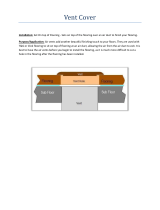
Table of Contents
1 General Site Preparation Guidelines...........................................................................7
Electrical Factors.....................................................................................................................................7
Synopsis.............................................................................................................................................7
AC Electrical Distribution System...............................................................................................7
AC Power Quality Devices..........................................................................................................8
UPS Recommendations................................................................................................................8
Power Consumption....................................................................................................................8
Grounding Systems......................................................................................................................9
Comprehensive Discussion...............................................................................................................9
Computer Room Safety...................................................................................................................10
Fire Protection............................................................................................................................10
Fire Suppression.........................................................................................................................10
Lighting Requirements for Equipment Servicing......................................................................10
Cabinet Recommendations........................................................................................................10
Working Space for Product Access............................................................................................11
Power Consumption........................................................................................................................11
Electrical Load Requirements (Circuit Breaker Sizing)...................................................................11
Power Quality..................................................................................................................................11
Sources of Voltage Fluctuations.................................................................................................11
Power System Protection............................................................................................................12
Distribution Hardware....................................................................................................................12
Wire Selection.............................................................................................................................12
Raceway Systems (Electrical Conduits) (LAHJ).........................................................................12
Building Distribution.................................................................................................................13
Grounding Systems.........................................................................................................................13
Power Distribution Safety Grounding (LAHJ)..........................................................................13
Main Building Electrical Ground..........................................................................................13
Electrical Conduit Ground....................................................................................................13
Power Panel Ground.............................................................................................................13
Computer Safety Ground.....................................................................................................13
Dual Power Source Grounding.............................................................................................14
Cabinet Performance Grounding (High-Frequency Intercabinet Ground)...............................14
Raised Floor “High-Frequency Noise” Grounding...................................................................14
Equipment Grounding Implementation Details........................................................................15
System Installation Guidelines........................................................................................................15
Acclimatization..........................................................................................................................16
Wiring Connections....................................................................................................................16
Data Communications Cables....................................................................................................16
Environmental Elements.......................................................................................................................16
Synopsis...........................................................................................................................................16
Air Quality.................................................................................................................................16
Airflow.......................................................................................................................................17
Equipment Orientation..............................................................................................................18
Electrostatic Discharge (ESD): Source of Greatest Failure Rate Without Detection..................18
Cellular Telephone and Wireless Usage.....................................................................................18
Comprehensive Discussion.............................................................................................................18
Computer Room Preparation..........................................................................................................19
Airflow.............................................................................................................................................19
Row Orientation.........................................................................................................................19
Dust and Pollution Control........................................................................................................20
Metallic Particulate Contamination...........................................................................................21
Table of Contents 3





















